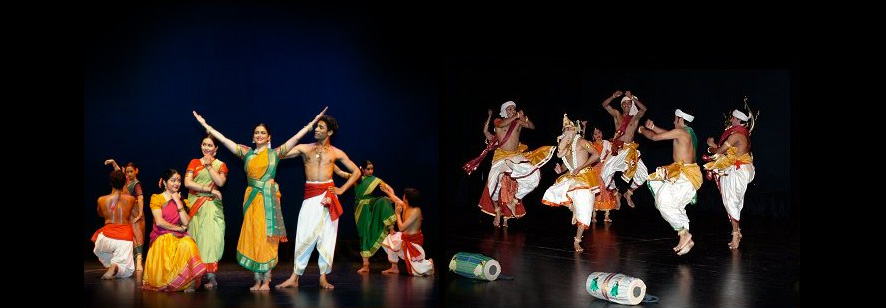Introduction

The Dhananjayans’ lives revolve around their students and their performances. Their relationships with their students are quite different from those of traditional dance teachers. The students love the relaxed atmosphere at Bharata Kalanjali and the personal attention they receive. They are free to discuss any aspect of their lives with their gurus and are encouraged to bring out their personalities in dance as well as in their private lives. The Dhananjayans are proud to claim that they have the distinction of performing items choreographed by their students.
Consistent training in Bharata Kalanjali has shaped many such students into excellent human beings, teachers, and professionals who are leading very happy, satisfying lives. Some of them have become University rank holders, brilliant doctors, and academicians.
The Dhananjayans proudly affirm that they have achieved at least 90% success in this. Maybe about 2-3% of Bharata Kalanjali students have taken up dance as a career but the others are using the discipline learned here in their own careers.
More foreign students followed Katherine and the added revenue was not only helpful, it helped the Dhananjayans to better the facilities. They took a bigger cottage and the thatched roof now covered a bigger space. It was very convenient to hold classes and rehearsals.
The steady influx of foreign and Indian students boosted Bharata Kalanjali’s reputation in the dance field. One such excellent student from America was Sheila Christian, who stayed with the Dhananjayans for a long time and gave her debut performance at R R Sabha, Chennai. Overwhelmed by the performance, Kamala Lakshman who had been in the audience, came backstage after the show, hugged Sheila and openly declared that Sheila was much better than the Indian dancers! Sheila who had also learnt to play Carnatic music on the veena, is presently based in Alabama and celebrates the 25th anniversary of her dance school Natya Ananda in June 2003.
Katherine was given a sponsorship by the American Consulate to travel all over India to perform under the USIS banner and as her gurus, the Dhananjayans got the wonderful opportunity to accompany her and be part of the impeccably organized programs. At that time, the USIS used to encourage such art activities. The highly sophisticated organization of these programs and the professional treatment meted out, helped the Dhananjayans when it came to organizing their own programs.
Once Sheila completed her training, she also benefited from a USIS sponsorship.
Another remarkable student is flamenco dancer Gloria Mandelik in Spain who does not do so much Bharatanaatyam, as a combination of the different dance styles she works with.
Bharata Kalanjali became something of a resort to foreigners!
Many of these dancers were wanted to fill in for the foreigners’ roles in movies, but the Dhananjayans did not encourage this. In those days, dalliances with cinema would have attached a stigma to the name of the institution and they did not want that to happen to something they had struggled to achieve
Consistent training in Bharata Kalanjali has shaped many such students into excellent human beings, teachers, and professionals who are leading very happy, satisfying lives. Some of them have become University rank holders, brilliant doctors, and academicians.
The Dhananjayans proudly affirm that they have achieved at least 90% success in this. Maybe about 2-3% of Bharata Kalanjali students have taken up dance as a career but the others are using the discipline learned here in their own careers.
STUDENTS FROM OUTSIDE INDIA
In those days, Kalakshetra offered only short-term training courses to foreign students. Those students furthered their training with Bharata Kalanjali since they followed the same tradition as Kalakshetra. One such student was Katherine, who stayed with the Dhananjayans as a paying guest. Katherine was the first foreigner whose arangetram was conducted by Bharata Kalanjali and it took place at the Museum Theatre. This was the first arangetram of Bharata Kalanjali. Katherine is still active in her field and runs a dance school Kalanjali in California with her husband Kunhiraman, who was a teacher in Kalakshetra.More foreign students followed Katherine and the added revenue was not only helpful, it helped the Dhananjayans to better the facilities. They took a bigger cottage and the thatched roof now covered a bigger space. It was very convenient to hold classes and rehearsals.
The steady influx of foreign and Indian students boosted Bharata Kalanjali’s reputation in the dance field. One such excellent student from America was Sheila Christian, who stayed with the Dhananjayans for a long time and gave her debut performance at R R Sabha, Chennai. Overwhelmed by the performance, Kamala Lakshman who had been in the audience, came backstage after the show, hugged Sheila and openly declared that Sheila was much better than the Indian dancers! Sheila who had also learnt to play Carnatic music on the veena, is presently based in Alabama and celebrates the 25th anniversary of her dance school Natya Ananda in June 2003.
Katherine was given a sponsorship by the American Consulate to travel all over India to perform under the USIS banner and as her gurus, the Dhananjayans got the wonderful opportunity to accompany her and be part of the impeccably organized programs. At that time, the USIS used to encourage such art activities. The highly sophisticated organization of these programs and the professional treatment meted out, helped the Dhananjayans when it came to organizing their own programs.
Once Sheila completed her training, she also benefited from a USIS sponsorship.
Another remarkable student is flamenco dancer Gloria Mandelik in Spain who does not do so much Bharatanaatyam, as a combination of the different dance styles she works with.
Bharata Kalanjali became something of a resort to foreigners!
Many of these dancers were wanted to fill in for the foreigners’ roles in movies, but the Dhananjayans did not encourage this. In those days, dalliances with cinema would have attached a stigma to the name of the institution and they did not want that to happen to something they had struggled to achieve
